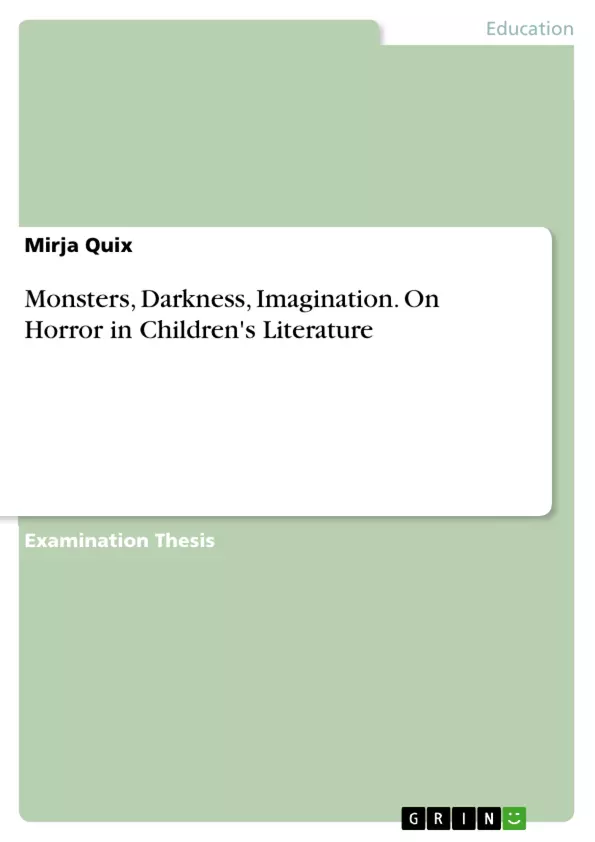The aim of this work is to explore the nature of elements of horror in literature for children and what their effect on young readers can be. In addition, it will distinguish why elements of horror should be part of literature for child readers.
The first part will have a look at different aspects of children’s literature as such, starting with the history of its development and an attempt to define it as a genre, taking into consideration the relationship between child readers and adult writers. This part will supply a general overview of problems the genre’s definition causes, as well as the discrepancies between the child reader’s needs and what adults want children to require from literature.
The second part then focuses on horror literature, including Gothic Horror and fairy tales, before looking at horror literature for children. In this part, a determination of what constitutes horror in literature is made before the terminology of children’s literature is broadened to the field of horror.
The third part of this work takes a closer look at aspects of horror in literature for children, analysing different elements like child fears, danger and monsters in selected books. It deconstructs what can be perceived as scary in books for young readers, how frightening elements are incorporated into literature for children, using well- known books from authors like Lewis Carroll, J. M. Barrie or Roald Dahl as representatives, while in the end looking at positive effects horror in literature for young readers has on a child.
Table of Contents
- Introduction
- Children's Literature
- History of Children's Literature
- Defining Children's Literature in Literary Studies
- Child Readers and Adult Writers
- Horror Literature
- The Gothic
- Children and Horror Literature
- Fairy Tales and Censorship
- Aspects of Horror in Children's Literature
- The Uncanny and the Unconscious
- Normality and Otherness
- Other Worlds and Parallel Universes
- Mothers and Other Wicked Women
- Animals
- Lurking Danger and Death
- Being Trapped, Being Lost and Being Small
- Being Devoured and Vanishing
- Being Left and Being Alone
- Monsters
- Illustrations
- Why should Children read Horrific Literature?
- Pleasure
- Humour
- Overcoming Fear
- Conclusion
- Sources
Objectives and Key Themes
This work explores the nature of horror elements in children's literature and their potential effects on young readers. It aims to explain why these elements are important for children's literature. The paper examines various aspects of children's literature, including its history, definition, and the relationship between child readers and adult writers. It also delves into the nature of horror literature and explores its presence in children's literature.
- The history and definition of children's literature
- The relationship between child readers and adult writers
- The nature of horror literature and its presence in children's literature
- The impact of horror elements on children's literature and their potential effects on young readers
- The reasons why horror elements should be included in children's literature
Chapter Summaries
The introduction presents various examples of horror elements in children's literature, highlighting the genre's versatility and the tension between the perceived innocence of childhood and the inclusion of scary elements. The chapter also introduces the paper's objectives and outlines its structure.
Chapter 2 discusses the challenges in defining children's literature, exploring different perspectives and the discrepancies between adult expectations and the actual needs of child readers. It provides a historical overview of the genre, tracing its development from the eighteenth century to the modern era.
Chapter 3 delves into the nature of horror literature, focusing on the Gothic genre and its relevance to children's literature. The chapter examines the inclusion of fairy tales in horror literature and discusses censorship efforts.
Chapter 4 examines various aspects of horror in children's literature, analyzing elements like child fears, danger, and monsters in selected books. It deconstructs how frightening elements are incorporated into children's literature and explores the positive effects of horror on young readers.
Keywords
Children's literature, horror literature, Gothic, fairy tales, censorship, child readers, adult writers, the uncanny, fear, monsters, imagination, pleasure, humour, overcoming fear, the history of children's literature, children and horror, aspects of horror in children's literature, illustrations, Why should children read horrific literature?
- Quote paper
- Mirja Quix (Author), 2016, Monsters, Darkness, Imagination. On Horror in Children's Literature, Munich, GRIN Verlag, https://www.grin.com/document/428701



